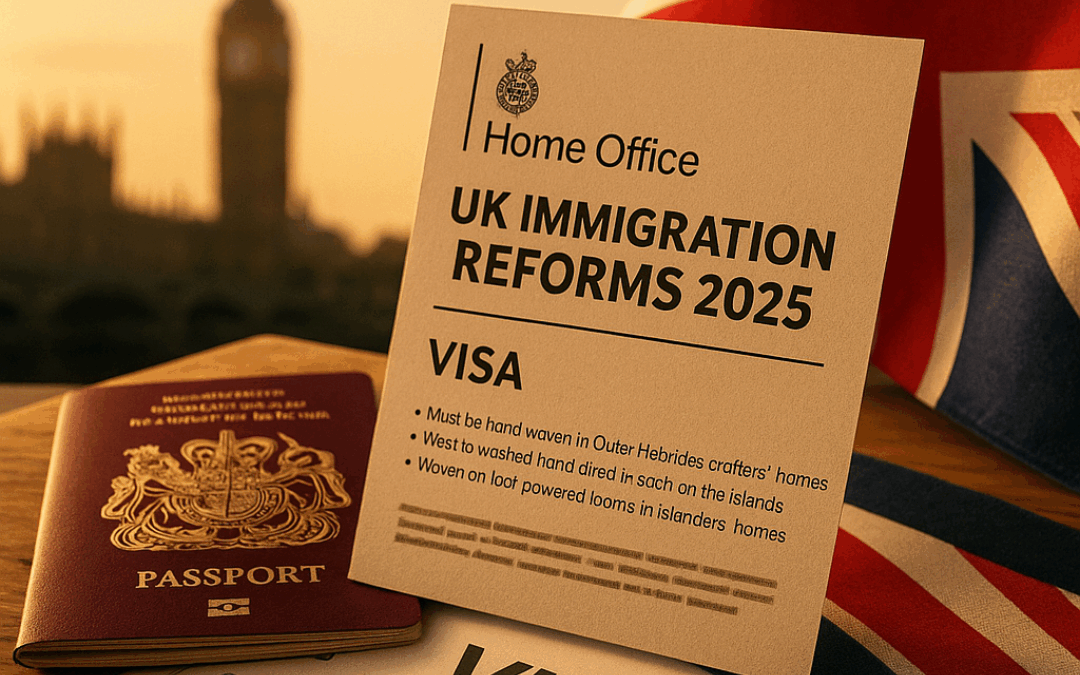
by Soniya Basu | Jul 23, 2025 | 2025 Changes
The United Kingdom’s new immigration white paper, Restoring Control over the Immigration System, came into effect on 22 July 2025, marking the first phase of sweeping reforms designed to reduce net migration, strengthen border integrity, and shift the balance in favour of highly skilled talent. Spearheaded by the Home Office under Prime Minister Sir Keir Starmer, this 82-page blueprint lays out radical changes to work, study, settlement, family, and asylum routes, with particularly profound implications for Indian students, professionals, and job seekers eyeing opportunities in Britain GOV.UKThe Times of India.
The Context: Record-High Migration and a New Direction
Between 2019 and 2023, UK net migration quadrupled from around 224,000 to over 900,000, driven in part by COVID-era visa extensions and robust international recruitment. With India now the UK’s largest source of migrants, the government has prioritised curbing overall numbers while still attracting the “brightest and best” global talent. This white paper signals a strategic pivot: encouraging domestic training, tightening visa eligibility, and instituting a data-driven Labour Market Evidence Group to guide future policy Financial TimesGOV.UK.
Raising the Bar for Skilled Workers
A cornerstone of the reforms is the restoration of the skill threshold for the Skilled Worker visa from Regulated Qualifications Framework (RQF) Level 3 (A-Level equivalent) back to RQF Level 6 (Bachelor’s degree equivalent) or above. This change, effective 22 July 2025, is accompanied by a substantial increase in minimum salary requirements and the abolition of the Immigration Salary List—an earlier discount system for lower-paid roles. Together, these measures ensure that only graduate-level positions attract overseas talent, signalling a clear shift towards prioritising high-value jobs and domestic workforce development GOV.UKRedditIndiatimes.
Narrowing Occupations and Safeguarding Social Care
In addition to raising skill levels, the white paper reduces the list of occupations eligible for sponsorship. Roles not on the new Shortage Occupation List will face time-limited entry permissions until the Migration Advisory Committee (MAC) reviews medium-skilled job needs beyond 2026. Crucially, the social care visa route for adult care workers will close to new applications from abroad, with a transition window until 2028 for existing visa holders to switch or extend in-country, underscoring the government’s drive to invest in homegrown care provision GOV.UKHouse of Commons Library.
Redefining the Student Experience
For international students, the reforms introduce stricter sponsor compliance and an action plan regime for at-risk institutions, including caps on new recruits. Most notably, the post-study work visa which was previously two years for undergraduate and three years for doctoral graduates will be capped at 18 months, down from two years for all graduates. This curtailment, paired with a 6 % levy on international tuition fees (for comparison; details vary), aims to balance the financial benefits of student visas with concerns about overstays and “visa tourism” GOV.UKIndiatimes.
UK Student Visa Guide – Your handbook on applying, compliance tips, and post-study options.
Streamlining Family and Settlement
The white paper also tackles what it calls “over-complex” family and private life routes, seeking to clarify the government and Parliament’s role in defining rights to remain in the UK. In parallel, the standard settlement (Indefinite Leave to Remain) qualifying period will double from five to ten years, and future citizenship criteria will move to an “earned settlement” points-based model that rewards economic and community contributions GOV.UK.
Empowering the Very Highly Skilled
While curbing lower-skilled routes, the UK is simultaneously expanding pathways for top talent. The white paper commits to growing the Global Talent visa programme, increasing places for research interns, and reviewing the Innovator Founder and High Potential Individual routes. By fast-tracking exceptional scientists, designers, and entrepreneurs, the UK aims to remain globally competitive in sectors such as life sciences, digital technology, and creative industries GOV.UK.
Tougher Measures to Prevent Abuse
Recognising abuses in the system, the white paper proposes stricter conditions for sponsors—schools, universities, and employers along with financial penalties and sanctions for non-compliance. It also introduces new intervention powers for asylum seekers, including expedited removal processes where post-arrival asylum claims lack substance. For foreign national offenders (FNOs), deportation thresholds will be recalibrated to factor in the seriousness of offences beyond prison sentences GOV.UK.
Higher Language Requirements
To ensure migrants contribute fully, English language requirements across multiple visa categories will rise to CEFR B2 (Independent User), replacing the current B1 standard. Dependants will also face higher language expectations, reflecting the government’s emphasis on integration and reducing reliance on translation and interpretation services Dentons.
New Financial and Compliance Pressures
Employers can expect an uplift in the Immigration Skills Charge, with a 32 % increase in fees (from £1,000 to £1,320 annually per worker). Moreover, surcharges for healthcare and visa application fees will continue to rise, increasing the cost of sponsoring migrant workers. These financial measures aim to shift employer focus toward domestic recruitment and training programmes Dentons.
What It Means for Indian Students
With India supplying the highest share of UK student visas (nearly 25 % of the total), the reduction in post-study work opportunities represents a significant downgrade. Graduates now face a shorter window to seek sponsorship, requiring early engagement with UK employers or alternative pathways like the Graduate Trainee or Global Talent routes. Institutions with high Indian enrolment will need robust compliance processes to avoid sponsor sanctions GOV.UK.
Impact on Indian Professionals
For Indian professionals on the Skilled Worker route especially those in IT, engineering, and finance, the raise to RQF 6 and salary threshold increases may make switching or extending visas more challenging. Roles that once qualified under A-Level equivalents may no longer meet the criteria, compelling companies to upskill domestic staff or sponsor fewer overseas workers. This change could drive talent to alternative markets such as Canada and Europe GOV.UKFinancial Times.
Consequences for Job Seekers
Indian job seekers without sponsorship prospects now face higher entry barriers. The abolition of the Immigration Salary List and removal of lower-skilled routes limit options for entry-level positions. Instead, aspirants may explore short-term student visas or Global Talent schemes, but these demand specialist credentials or significant capital. Navigating the new Points-Based System will require strategic planning to accumulate the necessary skills and income thresholds GOV.UK.
How Businesses Should Prepare
UK employers anticipating future recruitment must conduct a skills audit, invest in domestic training, and develop robust sponsor compliance teams. Partnerships with local colleges and apprenticeship programmes can offset reliance on overseas labour, while clear records and audit trails will mitigate the risk of penalties under the strengthened sponsor regimes GOV.UK.
The white paper promises further asylum and border security reforms later this year, alongside consultation on expansion of earned settlement and citizenship. With many changes set to roll out across this Parliament, the UK’s immigration landscape is entering an era of tighter control, higher standards, and selective openness to global talent.
The UK’s “Restoring Control” white paper fundamentally reshapes immigration, balancing a dramatic reduction in net migration with targeted attraction of skilled talent. While the new measures are raising skill and salary thresholds, curbing post-study stays, and recalibrating settlement, present challenges for Indian students, professionals, and job seekers, they also underscore the UK’s commitment to high-value migration. As these reforms take hold, careful navigation of the new system, proactive skill development, and strategic employer engagement will be essential for all stakeholders.

by Soniya Basu | Jul 23, 2025 | Scotland Specials
Made in Scotland Series: Part 3
Nestled in the rugged, windswept landscapes of the Outer Hebrides lies one of Scotland’s most treasured exports: Harris Tweed. More than just wool, Harris Tweed is a living story, one that’s handwoven into the identity of Scotland itself. Protected by law, celebrated in fashion houses from Milan to Mumbai, and rooted in crofting communities, this world-famous cloth embodies the harmony of tradition, nature, and craftsmanship.
What Is Harris Tweed?
Harris Tweed is a tweed cloth that must be handwoven by islanders in their own homes in the Outer Hebrides, using 100% pure virgin wool dyed and spun in the Outer Hebrides. This unique origin and strict production method are legally protected by the Harris Tweed Act of 1993, making it the only fabric in the world governed by an act of Parliament.
The result? A rich, textured cloth that blends beauty, durability, and a deep sense of place.
From Croft to Loom: A Story of Heritage
Each metre of Harris Tweed begins with wool, often from Scottish Blackface sheep and it’s washed, dyed, and blended into earthy colour palettes inspired by the island’s natural tones: heather, moss, sky, and stone.
Islanders then handweave the wool on foot-powered looms in their homes. The rhythmic clack of the loom is a sound heard across Lewis, Harris, Uist, and Barra, where weaving is not just a job but a lifestyle, often passed down through generations.
Once woven, each bolt of cloth is inspected and stamped with the iconic Orb trademark, certifying its authenticity.
What began as a humble fabric worn by crofters and aristocrats alike has become a global fashion statement. From Savile Row suits and Chanel jackets to accessories, upholstery, and even sneakers. Harris Tweed bridges tradition with modern style.
Fashion designers love its character: it’s warm, water-resistant, eco-friendly, and steeped in storytelling.
For South Asians living in Scotland or abroad, Harris Tweed offers something special. A blend of timeless style and Scottish soul. Imagine a Harris Tweed Nehru jacket or sherwani , the perfect cross-cultural fusion.
In a fast-fashion world, Harris Tweed stands firm in its commitment to sustainability, slow production, and local economy. Supporting it means preserving skills, culture, and communities that might otherwise fade away.
For anyone who values quality, authenticity, and heritage, Harris Tweed is not just fabric, It’s a philosophy.
Where to Buy Harris Tweed
Want to experience it in person? Visit Scottish gift stores in Edinburgh or browse listings in the ScottishIndian.com Business Directory to support local retailers.
Made in Scotland is more than just a label — it’s a legacy. And Harris Tweed is its most stylish thread.
Stay tuned for Part 4 of the series as we explore Scottish brands.

by Soniya Basu | Jul 22, 2025 | Food Review
Tucked away on bustling Lothian Road, Don@Tokyo offers a refreshing alternative to Edinburgh’s pub-heavy dining scene. From the moment you step inside, the warm glow of paper lanterns, playful murals, and a playlist that balances melodies and laid-back jazz set the stage for an unforgettable meal.
We were greeted with genuine smiles, even before we’d had a chance to consult the menu. The staff patiently explained each section, answered our questions about tea varieties, and offered friendly recommendations. Their unobtrusive yet attentive style ensured that we felt unhurried.
Eager to dive in, we ordered:
- Miso Soup
A steaming bowl of traditional miso, dotted with silken tofu and chopped spring onions. Its gentle umami warmth was the perfect prelude to the meal.
Meanwhile, without any extra charge, the kitchen sent over:
- Edamame & Fresh Wasabi
The edamame arrived lightly salted and tender ideal for popping pod after pod.While a small dish of freshly grated wasabi delivered a clean, spicy kick that awakened our taste buds.
These thoughtful extras (priced into the meal rather than tacked on) signalled that Don@Tokyo values both quality and hospitality.
Meet the Stars: Chicken Katsu Roll and Prawn Tempura Bento
Presented on a sleek black plate, the Chicken Katsu Roll was a masterclass in texture and balance. Each bite combined:
- Crispy panko-coated chicken
- Soft, vinegared sushi rice
- A light drizzle of tangy katsu sauce and creamy spicy mayo
The crunch of the chicken against the pillowy rice made every mouthful addictive. A side of pickled ginger added a bright counterpoint, cutting through the richness and helping to refresh the palate.
Our second entrée, the Prawn Tempura Bento Box, was a feast for the senses:
- Four large prawns, enveloped in an airy, golden batter
- Fluffy steamed rice sprinkled with black sesame seeds
- Two crisp chicken gyoza
- Sautéed seeaweed tossed in sesame oil
- Bite-sized pieces of popcorn chicken glazed in a house-made sauce
Each component arrived hot and at peak crispness. The tempura prawns maintained their delicate crunch, while the dipping sauce, an elegant blend of soy, mirin, and grated ginger brought a subtle sweetness and heat that elevated every bite.
Want more sushi inspiration? Check out our Scottish-Indian Restaurant Guide for the best fusion spots around town.
A Refreshing Finale: Peach Hojicha
To pair with our mains, we chose Peach Hojicha—iced hojicha tea infused with natural peach essence. The smoky undertones of the roasted green tea blending beautifully with the soft fruit sweetness, offering a palate-cleansing sip between bites and a refreshing finish.
Dining at Don@Tokyo feels like visiting a friend who happens to be a master chef. The décor strikes a perfect balance between modern minimalism and playful Japanese pop culture. Service is friendly without being overbearing, and the soundtrack creates a relaxed ambiance that encourages lingering conversation.
All this excellence came at a remarkably fair price. Our total bill for two—covering miso soup, complimentary edamame and wasabi, two substantial mains, and one glass of peach hojicha was around £26. In Edinburgh’s dining landscape, that level of quality and generosity is a true bargain.
If you’re craving authentic Japanese cuisine or curious about tea culture, make your way to Don@Tokyo on Lothian Road. You can even plan ahead by visiting their official site at www.donatokyo.com.Whether it’s a solo tea break, a casual date, or dinner with friends, you’ll leave with your heart (and stomach) full.
Have you tried Don@Tokyo? Share your own photos and experiences using #scottishindiancom — we’d love to feature your favourite dish next!

by Soniya Basu | Jul 22, 2025 | Scotland Specials
Made in Scotland series – Part 2:
When it comes to iconic Scottish treats, few inspire the level of loyalty, nostalgia, and cheeky indulgence as a red-and-gold wrapped Tunnock’s Tea Cake or the layered glory of a Caramel Wafer.
Whether you first tried them at school, during tea with gran, or at a community event, Tunnock’s confections are more than just snacks. These are a shared cultural experience in Scotland.
🏭 A Family Brand with Deep Roots
Tunnock’s has been a household name since 1890, when Thomas Tunnock opened a bakery in Uddingston, a small town near Glasgow. Over 130 years later, the fourth generation of the Tunnock family is still running the show and their products have reached iconic status not just in Scotland, but across the UK and beyond. Explore their full range of products and history on the official Tunnock’s website.
🍥 What Is a Tunnock’s Tea Cake?
A light biscuit base, topped with a dome of fluffy Italian mallow, all coated in a layer of silky milk chocolate. It’s soft, gooey, and messy in the best way.
Fun Fact: It’s not actually a cake. It’s more of a biscuit but try arguing that in a Scottish tea room.
🧇 The Caramel Wafer
Thin layers of crispy wafer with chewy caramel in between, all covered in chocolate. It’s the ultimate lunchbox classic and still one of the best-selling biscuits in Scotland.
Over 5 million are made every week at the Uddingston factory!
Desi families in Scotland quickly adopted Tunnock’s into everyday life. Whether it’s tea at a temple, a cultural festival, or a kids’ birthday party, you’ll often find a plate of Tea Cakes right next to the samosas.
There’s something about the balance of sweetness and texture that fits well with Indian and Pakistani chai culture.
check out IRN-BRU: The Soft Drink That Outsold Coca-Cola in Scotland for another taste of Scottish obsession.
🌍 Global Fame, Local Pride
From being served in British Embassies to making appearances in viral memes, Tunnock’s has become a symbol of both Scottish identity and cross-cultural delight.And if you’re curious about other traditional Scottish snacks, check out Scotland.org’s guide to iconic treats.
In fact, the red-and-gold foil has even inspired fashion prints, Christmas decorations, and art installations.
You can find Tea Cakes and Caramel Wafers in nearly every major supermarket in Scotland:
- Tesco, Asda, Sainsbury’s, Morrisons
- Desi convenience stores like Costcutter and Best-One (see our Grocery Directory for more!)
Planning to send some to loved ones abroad? They travel well, just wrap them tight.
☕️ How to Enjoy Them – Desi Style
- Chai + Tea Cake: Let the mallow melt on your tongue between sips of masala chai
- Caramel Wafer Sundae: Chop it up over kulfi or vanilla ice cream
- Tea Cake S’mores: Lightly toast and sandwich between Marie biscuits
Tunnock’s is more than a sweet treat. It’s a taste of Scottish heritage with global appeal. If you haven’t had one yet, grab a pack, pour yourself some chai, and see what the obsession is all about.

by Soniya Basu | Jul 21, 2025 | Rights & Skills
A new era of academic mobility has arrived and it’s called APAAR.
Recently, Indian social media has been buzzing with influencers talking about a “Special Academic Passport”, and you may have seen reels, hyping it up with green ticks and serious excitement.
But what exactly is APAAR, and why do influencers call it a game-changer for students…?
🎓 What Is APAAR?
APAAR stands for Automated Permanent Academic Account Registry.
Think of it as a unique lifelong academic ID. A digital passport that will store all your learning credentials from school to higher education, across institutions, states, and even countries.
It’s a central feature of the Indian Government’s National Education Policy (NEP) reforms.
Why It’s Being Called an “Academic Passport”
Much like how your physical passport helps you move between countries, APAAR will help your academic records move across universities and systems. Whether you’re shifting schools in India, applying for university abroad, or pursuing online learning, APAAR will:
✅ Digitally track all your certificates, credits & degrees
✅ Standardise transcripts
✅ Make credit transfers easier
✅ Create a verified profile for future employers or institutions
This is especially big for Indian students dreaming of studying abroad or pursuing hybrid education.
If you’re a NRI student, part of the Indian diaspora, or planning to return to India for higher education, APAAR could simplify how your credentials are accepted across borders.
➡️ No more revalidating transcripts multiple times
➡️ Easy transfer between international and Indian institutions
➡️ Long-term career benefit via digital academic proof
For a deep dive into documentation and visa tips, see our UK-India Student Visa Changes Explained (2025)
Who Is Eligible?
The government is rolling out the APAAR system in phases:
- School students are being issued IDs first via DigiLocker
- College & university students can link their academic records through the National Academic Depository (NAD)
- Future integrations may include professional certifications and skill-based credentials
If you’re currently in Class 9 to university level, you’ll likely be onboarded soon through your educational institution.
Like any major change, APAAR has sparked questions:
🔐 Data Privacy – The government says it complies with data protection guidelines and gives students control over visibility.
📄 Opt-Out Option – Some have raised concerns about it being mandatory. As of now, it’s voluntary, but encouraged for long-term benefits.
🌐 Digital Divide – Implementation might be slower in rural or underserved areas, but digital onboarding via DigiLocker is helping bridge that gap.
Will APAAR Help Me Study Abroad?
Short answer: Not directly, but it can strengthen your applications.
APAAR will give universities abroad a verified and standardised format of your academic record especially useful for visa documentation, credential evaluation, and even job applications.
APAAR is being positioned not just as a policy shift, but as a new cultural touchpoint. It represents India’s push toward digital education, global mobility, and a transparent academic system.
The APAAR Academic Passport isn’t just a document. It’s a step toward making your academic journey borderless, portable, and future-ready.
🎒 Students: Check with your school or college about onboarding.
📲 Parents: Get familiar with DigiLocker.
🌍 Diaspora: Stay updated via the Ministry of Education Portal.
📚 Related Reads on ScottishIndian.com
📌 Follow @ScottishIndian for updates that matter to our community—from education to immigration and everything in between.




